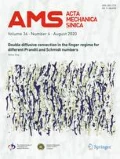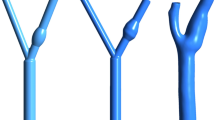Abstract
Arterial bifurcations are places where blood flow may be disturbed and slow recirculation flow may occur. To reveal the correlation between local oxygen transfer and atherogenesis, a finite element method was employed to simulate the blood flow and the oxygen transfer in the human carotid artery bifurcation. Under steady-state flow conditions, the numerical simulation demonstrated a variation in local oxygen transfer at the bifurcation, showing that the convective condition in the disturbed flow region may produce uneven local oxygen transfer at the blood/wall interface. The disturbed blood flow with formation of slow eddies in the carotid sinus resulted in a depression in oxygen supply to the arterial wall at the entry of the sinus, which in turn may lead to an atherogenic response of the arterial wall, and contribute to the development of atherosclerotic stenosis there.
Similar content being viewed by others
References
Eikelboom B.C. and Strandness D.E. (1998). Carotid artery stenosis-where do we go from here?. Eur. J. Ultrasound 7(Suppl. 3): 17–26
Naidu K.A. (2003). Vitamin C in human health and disease is still a mystery? An overview. Nutr. J. 2: 7
Laurent S. (2003). Drugs and arterial stiffness in hypertensive patients. Drugs 1: 1–8
Crawford D.W., Back L.H. and Cole M.A. (1980). In vivo oxygen transport in the normal rabbit femoral arterial wall. J. Clin. Invest. 65: 1498–1508
Crawford D.W. and Blankenhorn D.H. (1991). Arterial wall oxygenation, oxyradicals and atherosclerosis. Atherosclerosis 89: 97–108
Qiu Y.C. and Tarbell J.M. (2000). Numerical simulation of oxygen mass transfer in a compliant curved tube model of a coronary artery. Ann. Biomed. Eng. 28: 26–38
Deng X.Y., Marois Y. and How T. (1995). Luminal surface concentration of lipoprotein (LDL) and its effect on the wall uptake of cholesterol by canine carotid arteries. J. Vasc. Surg. 21: 135–145
Lever, J.M.: Mass transport through the walls of arteries and veins. In: Biological Flows, pp. 177–198. Plenum, New York (1995)
He Y., Shirazaki M. and Liu H. (2006). A numerical coupling model to analyze the blood flow, temperature, and oxygen transport in human breast tumor under laser irradiation. Comput. Biol. Med. 36: 1336–1350
Reuck J.D., Paemeleire K. and Decoo D. (2003). Cerebral blood flow and oxygen metabolism in symptomatic internal carotid artery occlusion by atherosclerosis and by cervical dissection. J. Stroke Cerebrovasc. Dis. 12(4): 163–168
Perktold K., Leuprecht A. and Prosi M. (2002). Fluid dynamics, wall mechanics, and oxygen transfer in peripheral bypass anastomoses. Ann. Biomed. Eng. 30: 447–460
Karino T. (1986). Microscopic structure of disturbed flows in arterial and venous systems and its implication in the localization of vascular disease. Int. Angiol. 4: 297–313
Taylor C.A., Thomas J.R. and Zarins C.K. (1998). Finite element modeling of blood flow in arteries. Comput. Methods Appl. Mech. Eng. 158: 156–196
Ku D.N., Giddens D.P. and Zarins C.K. (1990). Pulsatile flow and atherosclerosis in the human carotid bifurcation. Arteriosclerosis 12(5): 293–302
Ma P., Li X. and Ku D.N. (1997). Convective mass transfer at the carotid bifurcation. J. Biomech. 30(6): 565–571
Brogi E., Schatteman G. and Wu T. (1996). Hypoxia-induced paracrine regulation of vascular endothelial growth factor receptor expression. J. Clin. Invest. 97: 469–476
Simon M., Grone E.F., Grone and H.J. (1995). Expression of vascular endothelial growth factor in renal vascular disease and renal allografts. J. Pathol. 177: 259–267
Liu Y., Cox S.R. and Morita T. (1995). Hypoxia regulates vascular endothelial growth factor gene expression in endothelial cells. Identification of a 5 ft enhancer. Circ. Res. 77: 638–643
Fatouraee N., Deng X.Y. and De Champlain A. (1998). Concentration polarization of low density lipoproteins (LDL) in the arterial system. Ann. NY Acad. Sci. 858: 137–146
Schneiderman G. and Goldstick T.K. (1978). Carbon monoxide-induced arterial wall hypoxia and atherosclerosis. Arteriosclerosis 30(1): 1–15
Okamoto R., Hatani M. and Tsukitani M. (1983). The effect of oxygen on the development of atherosclerosis in WHHL rabbits. Arteriosclerosis 47(1): 47–53
Thier C.R. (2002). Computational modeling of mass transfer and links to atherosclerosis. Ann. Biomed. Eng. 30: 461–471
Author information
Authors and Affiliations
Corresponding author
Additional information
The project supported by the National Natural Science Research Council of China (10632010, 10572017, 30670517).
Rights and permissions
About this article
Cite this article
Zhang, Z.G., Fan, Y.B. & Deng, X.Y. Oxygen transfer in human carotid artery bifurcation. Acta Mech Sin 23, 305–309 (2007). https://doi.org/10.1007/s10409-007-0080-7
Received:
Revised:
Accepted:
Published:
Issue Date:
DOI: https://doi.org/10.1007/s10409-007-0080-7




